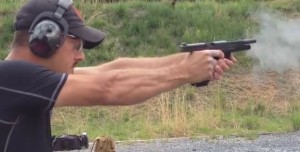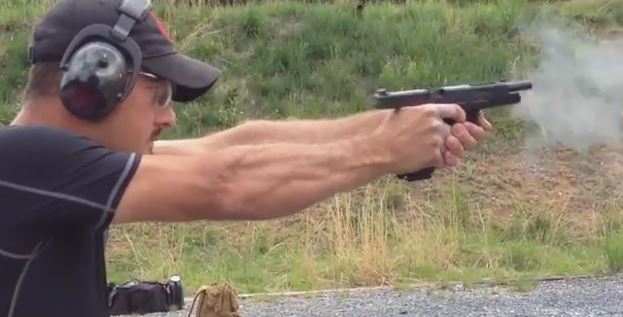If I use the term “gamer” as an adjective for a firearm, a modification to a firearm, or an accessory for a firearm, what definition pops into your mind? Exact definitions may vary, but I’d wager few would view the term as a positive description. Typically when you hear someone referring to something as “gamer” gear, it’s said almost through clenched teeth like they’re spitting the word out in contempt. The implication is that “gamers” aren’t serious, and therefore their equipment is goofy, problematic, and counterproductive…but is that really the case?
When you look at the upper echelon of the shooting sports and what it’s typically taken for the people in that top tier to achieve that level of success, it’s rather difficult to argue that those people aren’t serious about what they are doing. I’ve interacted with a few famous competitive shooters and I’ve never come away with the impression that they are some clueless jabroni who just has a trick gun. I may not agree with everything they do, but spend any time talking to a Rob Leatham, Bob Vogel, or Jerry Barnhardt and it’s crystal clear that they’ve invested incredible time and effort into what they’re doing. There’s thoughtful analysis, useful practice, and fastidious attention to detail behind their achievements. The same can be said for shooters who don’t necessarily belong to the Super Squad. There are a bunch of really good shooters out there who may not have won a major championship yet, but will still easily clean the clock of 99.99%+ of people who will ever pick up a firearm in just about any measure of shooting skill.
The thoughtful analysis and fastidious attention to detail goes beyond technique and into the equipment that they use. You won’t find anyone who is serious about competition shooting that isn’t also knowledgeable about their equipment and why they are using it. The idea that competitive shooters don’t know about gear is specious…they know their gear very well and they can usually explain exactly why they are using X vs. Y.

When I say “their gear” I’m referring to using firearms, modifications to firearms, or accessories that are suitable for the goal they are working towards. Competitive shooting, whatever form it takes, is specialized and typically you see specialized weapons and equipment tailor made for the discipline. Olympic skeet shooters tend to use expensive, specialized over and under shotguns customized to their specific physiology. Kim Rhodes’ shotgun is set up for her measurements and her shooting style. She’s not dependent upon that shotgun to hit a target. It’s been set up to hit flying clay discs reliably and optimized for her particular needs in the demanding environment of skeet competition. (Anyone who thinks it’s not demanding should be able to easily go out and being home a gold medal, right?) The gun has been set up to allow her the best possible performance in her sport. It’s “gamer” gear, but there’s nothing haphazard about the gun itself or her decision to use it. A custom Perazzi is a damn good gun. I’d love to own one.
…but it’s not the gun I would reach for if I was trying to breach the doors of a building to go deal with an active shooter.
The dismissal of “gamer” gear often comes from the “tactical” side of the house which is quick to point out that equipment specialized for competitive endeavors is often inappropriate or even counterproductive for use on the two-way range. This is certainly true, to an extent. Ms. Rhodes’ shotgun is a fine weapon, but no infantry platoon on earth would be better off with her shotgun than a decent belt-fed machinegun. Similarly, Ms. Rhodes would find an M240 to be particularly ill-suited for her purposes in the Olympics. We all recognize equipping an infantry machinegunner trying to achieve fire superiority with a double-barrel shotgun or an Olympic skeet shooter trying to hit clays with a belt fed as a silly exercise. (Although belt fed machinegun competitions would make the Olympics more awesome) It’s clearly the wrong tool for the job.
Does it follow, then, that every bit of equipment used in competition is unsuitable for consideration by people who are primarily concerned with using a firearm as a tool of personal defense? Nope. Understanding what’s what first requires understanding the frame of reference for competition gear and how it differs from requirements for defensive gear.
…which we’ll talk about next time.

Huh… when I say something is gamer gear, I mean one of two things, neither of them particularly derogatory:
1) It is specialized for the rules of a sport in a way that is not generally useful. Something like how IPSC is full of DA/SA CZ’s because of the way you can tune the trigger to match the rules, or holsters that barely hold a gun in place but let you draw it crazy fast, or the custom-molded grips you see on bullseye guns.
2) It sacrifices reliability for peak performance. You see this in cars as well – a race-tuned engine needs completely rebuilt every year. Something like a Saiga is going to give you a big performance advantage – if it works through the match. Which when you’re taking competition seriously, in most games a decent chance of a big advantage is more highly rewarded than consistency. We remember the guy who won once more than the guy who got 6th place five years running.
I think I mentally draw the line based on who’s doing the shooting. The guy at a match with a $6000 setup who’s getting his clock cleaned by the 18 year old with a borrowed stock Glock is simply trying to buy his way up the food chain and is gaming the system. The GM shooting the same setup is refining and honing every last bit of capability out of the system…and would likely still beat the rest of us even if we forced him to use a j-frame.
Equipment over emphasized while actual skill is ignored. Thanks for putting this out! I had a similar breakdown here:
http://firearmusernetwork.com/2012/06/10/race-guns-vs-regular-guns/
Exactly…
There’s exceptions to every rule, but most of the people who rag on open guns, or “gamer gear”, are the same people who couldn’t win no matter what equipment they were using. Again, there are exceptions to every rule but, in most cases, I see it as people just making excuses for why they aren’t as good as they want to be or think they are.
It’s the Indian, not the arrow!
I have ALWAYS used “gamer gear”, “space guns”, and “race guns” to mean exactly what Mike alluded to, above — specialized contest gear that scarifices “practicality” for competitive advantage. But it _isn’t_ derogatory when referring to the gear designed, intended, and used for its particular sport. An F1 car is “gamer gear” and wouldn’t even be _capable_ of functioning as a daily driver (much less a “beater” for winter). Doesn’t mean it’s a bad car. . . for it’s purpose.
When I _do_ use “gamer” as a derogatory term, it is to refer to _people_ bringing their highly competition-specialized gear into a “real world” application, in the false belief that the advantages in competition translate directly into performance advantages in a practical setting, obviating the need to actually develop skills. (However, not all use of “gamer gear” in Real World apps is invalid. . . I recall the tale of the IPSC shooter who was questioned as to why he used his racegun and .38 Super Major SWC loads as his defensive arm when going to and from local matches. He said, it’s a reliable gun, the actual risks of need between here and home are infintesimally small even compared to day to day life, and while the load sucks for antipersonnel use, there are plenty in the mag and slide lock is your friend.)
However, just as the Indy 500 improved daily driver automotive technology by serving as a test bed for tech, IPSC & 3-gun has served the same role as well. Now, equipment that started out as “gamer” stuff is readily accepted in a slightly less efficient (but FAR more durable and reliable) form as “ready for prime time”. You think we’d be seeing the proliferation of compensators and small red dots without the gamers to prove the concepts and create a market to entice inventors to imrpove?